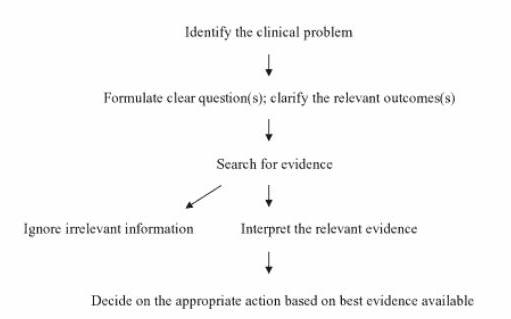Evidence-based dentistry is time consuming and thorough.
The principles and methods of evidence-based dentistry gives dentists the opportunity
to apply relevant research findings to the care of their patients.

Step I consists of narrowing the problem. The acronym PICO is a systematic way to
identify important concepts in a case, and formulate a question for searching. This
involves the following:
- The patient's disorder or disease.
- The intervention or finding under review.
- A comparison intervention.
- The outcome.
To determine the best clinical approach for the patient, a four-step evidence-based
model is demonstrated, consisting of the following: definition of a research question
using the PICO format, search and selection of relevant literature, critical appraisal
of identified research reports using checklists and the application of evidence.
There are many sources of information on dental treatment and on causes of oral
diseases. Published articles in medical and dental journals are now available easily,
using electronic databases such as Pubmed. Organisations produce summaries of the
evidence on particular therapies and guidelines about their use. The evidence found
will come from various types of studies, employing different methodologies:
- Cross Sectional Studies.
- Case Control Studies.
- Cohort Studies.
- Systematic Reviews.
- Narrative Reviews.
This is the most difficult aspect of reading a research paper.The three aspects
that are fundamental to interpreting research results are :
- The size of the effect of the treatment.
-
Do the observed results represent a real effect or are they likely to be a chance
finding?
-
Research results are always based on a sample of people, would we see similar results
if we took another example?
The definition of the outcome measures chosen to demonstrate the effect of a treatment
is central to the consideration of these issues. All research studies involve measuring
outcomes. We always need to consider whether the measure used in a particular study
is both meaningful and appropriate for addressing the question that prompted us
to search the information.
Outcomes can be described as true or surrogate endpoints. True endpoints are those
that have clear and direct clinical relevance to the patient.
A surrogate outcome is usually assumed to be the precursor to the true outcome.
Surrogate outcomes are generally objective measures that can be assessed in the
short term.
The information obtained from assessing the evidence should then be considered in
relation to the question that prompted you to undertake the search.






